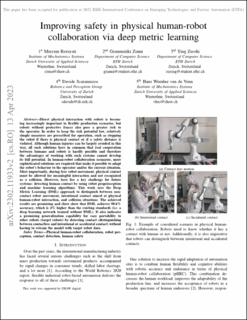Please use this identifier to cite or link to this item:
https://doi.org/10.21256/zhaw-26917Full metadata record
| DC Field | Value | Language |
|---|---|---|
| dc.contributor.author | Rezayati, Maryam | - |
| dc.contributor.author | Zanni, Grammatiki | - |
| dc.contributor.author | Zaoshi, Ying | - |
| dc.contributor.author | Scaramuzza, Davide | - |
| dc.contributor.author | van de Venn, Hans Wernher | - |
| dc.date.accessioned | 2023-02-11T10:23:19Z | - |
| dc.date.available | 2023-02-11T10:23:19Z | - |
| dc.date.issued | 2022 | - |
| dc.identifier.isbn | 978-1-6654-9996-5 | de_CH |
| dc.identifier.other | arXiv:2302.11933 | de_CH |
| dc.identifier.uri | https://digitalcollection.zhaw.ch/handle/11475/26917 | - |
| dc.description.abstract | Direct physical interaction with robots is becoming increasingly important in flexible production scenarios, but robots without protective fences also pose a greater risk to the operator. In order to keep the risk potential low, relatively simple measures are prescribed for operation, such as stopping the robot if there is physical contact or if a safety distance is violated. Although human injuries can be largely avoided in this way, all such solutions have in common that real cooperation between humans and robots is hardly possible and therefore the advantages of working with such systems cannot develop its full potential. In human-robot collaboration scenarios, more sophisticated solutions are required that make it possible to adapt the robot’s behavior to the operator and/or the current situation. Most importantly, during free robot movement, physical contact must be allowed for meaningful interaction and not recognized as a collision. However, here lies a key challenge for future systems: detecting human contact by using robot proprioception and machine learning algorithms. This work uses the Deep Metric Learning (DML) approach to distinguish between noncontact robot movement, intentional contact aimed at physical human-robot interaction, and collision situations. The achieved results are promising and show show that DML achieves 98.6% accuracy, which is 4% higher than the existing standards (i.e. a deep learning network trained without DML). It also indicates a promising generalization capability for easy portability to other robots (target robots) by detecting contact (distinguishing between contactless and intentional or accidental contact) without having to retrain the model with target robot data. | de_CH |
| dc.language.iso | en | de_CH |
| dc.publisher | IEEE | de_CH |
| dc.rights | http://creativecommons.org/licenses/by-nc-sa/4.0/ | de_CH |
| dc.subject | Physical human-robot collaboration | de_CH |
| dc.subject | Robot perception | de_CH |
| dc.subject | Contact detection | de_CH |
| dc.subject | Human safety | de_CH |
| dc.subject.ddc | 006: Spezielle Computerverfahren | de_CH |
| dc.subject.ddc | 621.3: Elektro-, Kommunikations-, Steuerungs- und Regelungstechnik | de_CH |
| dc.title | Improving safety in physical human-robot collaboration via deep metric learning | de_CH |
| dc.type | Konferenz: Paper | de_CH |
| dcterms.type | Text | de_CH |
| zhaw.departement | School of Engineering | de_CH |
| zhaw.organisationalunit | Institut für Mechatronische Systeme (IMS) | de_CH |
| dc.identifier.doi | 10.1109/ETFA52439.2022.9921623 | de_CH |
| dc.identifier.doi | 10.21256/zhaw-26917 | - |
| zhaw.conference.details | 27th International Conference on Emerging Technologies and Factory Automation (ETFA), Stuttgart, Germany, 6-9 September 2022 | de_CH |
| zhaw.funding.eu | No | de_CH |
| zhaw.originated.zhaw | Yes | de_CH |
| zhaw.publication.status | acceptedVersion | de_CH |
| zhaw.publication.review | Peer review (Publikation) | de_CH |
| zhaw.title.proceedings | 2022 IEEE 27th International Conference on Emerging Technologies and Factory Automation (ETFA) | de_CH |
| zhaw.webfeed | DIZH Fellowship | de_CH |
| zhaw.webfeed | Industrie 4.0 | de_CH |
| zhaw.author.additional | No | de_CH |
| zhaw.display.portrait | Yes | de_CH |
| Appears in collections: | Publikationen School of Engineering | |
Files in This Item:
| File | Description | Size | Format | |
|---|---|---|---|---|
| 2022_Rezayati-etal_Improving-safety-in-physical-human-robot-collaboration.pdf | Accepted Version | 4.87 MB | Adobe PDF |  View/Open |
Show simple item record
Rezayati, M., Zanni, G., Zaoshi, Y., Scaramuzza, D., & van de Venn, H. W. (2022). Improving safety in physical human-robot collaboration via deep metric learning. 2022 IEEE 27th International Conference on Emerging Technologies and Factory Automation (ETFA). https://doi.org/10.1109/ETFA52439.2022.9921623
Rezayati, M. et al. (2022) ‘Improving safety in physical human-robot collaboration via deep metric learning’, in 2022 IEEE 27th International Conference on Emerging Technologies and Factory Automation (ETFA). IEEE. Available at: https://doi.org/10.1109/ETFA52439.2022.9921623.
M. Rezayati, G. Zanni, Y. Zaoshi, D. Scaramuzza, and H. W. van de Venn, “Improving safety in physical human-robot collaboration via deep metric learning,” in 2022 IEEE 27th International Conference on Emerging Technologies and Factory Automation (ETFA), 2022. doi: 10.1109/ETFA52439.2022.9921623.
REZAYATI, Maryam, Grammatiki ZANNI, Ying ZAOSHI, Davide SCARAMUZZA und Hans Wernher VAN DE VENN, 2022. Improving safety in physical human-robot collaboration via deep metric learning. In: 2022 IEEE 27th International Conference on Emerging Technologies and Factory Automation (ETFA). Conference paper. IEEE. 2022. ISBN 978-1-6654-9996-5
Rezayati, Maryam, Grammatiki Zanni, Ying Zaoshi, Davide Scaramuzza, and Hans Wernher van de Venn. 2022. “Improving Safety in Physical Human-Robot Collaboration via Deep Metric Learning.” Conference paper. In 2022 IEEE 27th International Conference on Emerging Technologies and Factory Automation (ETFA). IEEE. https://doi.org/10.1109/ETFA52439.2022.9921623.
Rezayati, Maryam, et al. “Improving Safety in Physical Human-Robot Collaboration via Deep Metric Learning.” 2022 IEEE 27th International Conference on Emerging Technologies and Factory Automation (ETFA), IEEE, 2022, https://doi.org/10.1109/ETFA52439.2022.9921623.
Items in DSpace are protected by copyright, with all rights reserved, unless otherwise indicated.